Do you have a dream to travel to have train tours China to Tibet? This China train tour will be your best choice. In this itinerary, in addition to visiting the sacred Tibet, you will also visit another city on the Qinghai-Tibet Plateau, Xining. On the train from Xining to Lhasa, there are oxygen inhalation equipment to help passengers who are experiencing altitude sickness. On such a train, you will feel very safe. In addition, during the whole trip, you will spend two nights on the trains from Xining to Lhasa and from Lhasa to Xi’an. Not only does this save you the cost of two nights in a hotel, but you will also enjoy the unparalleled night views of the Tibetan Qinghai-Tibet Plateau. On the trains, you will see Kunlun Mountain, Tanggula Mountain, and Nianqing Tanggula Mountain Qinghai Lake, Kekexili Natural Reserve, and so on. These beautiful sights make you enjoy the long-distance Lhasa train tour instead of being boring. This best-selected China train tour is prepared for you, just contact us now.

Welcome to Beijing! Beijing is a historical and cultural city with a history of three thousand years. Beijing used to be the capital of six dynasties in history. In more than 2000 years since the Yan State (1044 BC - 222 BC), many magnificent palace buildings were built, making Beijing the city with the largest number of imperial palaces, gardens, temples, and tombs in China.
When you get off the plane, your guide will wait for you at the exit holding a pick-up sign with your name on it. Then you will be taken to the hotel for a rest.
In the morning, we will first come to Tian’anmen Square, the largest city center square in the world. The entire square can accommodate 1 million people, with people standing side by side on it. One of main buildings here is the Tian’anmen Gate Tower. Do you know the main purpose of Tian’anmen Gate Tower? In the Ming and Qing Dynasties (1368 - 1912), it was the place where the imperial edict ceremonies were read out. On October 1, 1949, Mao Zedong, the first chairman of the People’s Republic of China, declared the founding of New China to the world on the gate tower. In the middle of the square stands the Monument to the People’s Heroes. It was built to commemorate the people’s heroes who died in the struggles for national liberation and the freedom and happiness of the people at home and abroad since 1840. It is made of more than 17,000 granites and white marbles. You can take pictures here.
After visiting Tian’anmen Square, we will go to the Forbidden City (closed on Monday). The Forbidden City is the largest and most complete imperial palace in China, with a history of more than 600 years. There are more than 9,000 rooms in the Forbidden City, which are all very gorgeous. There are 72 pillars in the Hall of Supreme Harmony, among which six are gold-plated, with golden dragons carved on them. The throne in this palace is also gold-plated. A more amazing thing is the stone sculpture behind the Hall of Preserving Harmony. The sculpture is 16.57 meters long, 3.07 meters wide, and 1.7 meters thick, weighing more than 200 tons. It is carved with the choppy sea and dragons flying in the clouds. The huge sculpture is the main decoration of the main royal road for the emperor to the Hall of Preserving Harmony. You will surely be amazed.
After lunch, we will go to the Lama Temple. During the Qing Dynasty (1636 - 1912), the Lama Temple was the most famous royal temple in Beijing. Today, the temple is the largest existing Tibetan Buddhist temple in Beijing. It is mainly composed of three exquisite memorial archways and five grand halls, covering about 6.6 hectares. Among these halls, Falun Hall is the integration of the Han and Tibetan cultures. You can see a huge bronze Buddha statue in the center of the hall. He is Master Tsongkhapa, the founder of the Gelug Sect of Tibetan Buddhism. Behind the statue of Tsongkhapa is a wood carving called Five Hundred Arhats Mountain. The mountain is carved from red sandalwood, which is nearly 5 meters high, 3.5 meters long, and 30 centimeters thick. On the mountain, you can see 449 arhats cast in five metals - gold, silver, copper, iron, and tin - with different and lifelike expressions and postures. There used to be 500 arhats, but the gold and silver ones was robbed during a war.
After visiting Lama Temple, we will go to the Summer Palace. As the largest and best-preserved royal garden in China, it is also known as the Royal Garden Museum. The lush forest of Wanshou Mountain and the rippling waters of Kunming Lake constitute a beautiful picture of the royal garden. Kunming Lake covers an area of more than 2 million square meters. There is a huge stone boat along the lake and several stone bridges with different styles on the lake. Among them, the Seventeen-Arch Bridge is the most eye-catching. There are dozens of stone pillars on the bridge, and a carved stone lion stands on top of each stone pillar in different posture, such as some of them are stepping on a stone ball, some of them are sitting upright and looking ahead, etc.
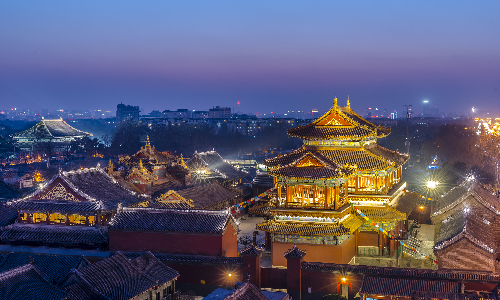
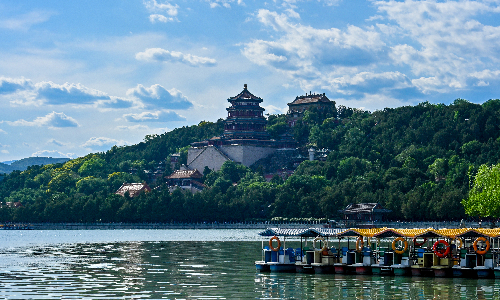
In the morning, we will go to the Chang Tomb of the Ming Tombs. The Ming Tombs are the tombs of the 13 emperors of the Ming Dynasty, located in Changping District in the north of Beijing, 50 kilometers away from the city center, less than 1.5 hours by car. The Chang Tomb is the largest and oldest one among the Ming Tombs. Ling’en Hall is the largest hall in it. It is on a three-story platform carved with white marble. Sixty pillars, made of golden nanmu with a diameter of more than one meter and a height of more than ten meters, support 2300-square-meter roof of the hall. In addition, there are hundreds of cultural relics unearthed from the Ding Tomb of the Ming Tombs on display, and a live video of the excavation of the Ding Tomb in 1956 is played.
After lunch, we will go to the Mutianyu Great Wall. The Mutianyu Great Wall is about 40 kilometers away from the Chang Tomb. We need to drive northeast for about one hour to get there. Mutianyu Great Wall is surrounded by mountains and has beautiful scenery. In spring, the flowers are blooming; in summer, the mountains become green; in autumn, red leaves spread all over the mountain and fruits are abundant; in winter, snow covers mountains which makes this place a fairyland. The Great Wall stretches from the mountainside to the top of the mountain with rises and falls. It is like a giant dragon lying on the mountain. Today you will stand on the back of the dragon and overlook surrounded mountains.
On the way back from the Mutianyu Great Wall, we will have a photo stop at the Bird’s Nest and the Water Cube. The Bird’s Nest, or National Stadium, is the main stadium of the 2008 Beijing Olympic Games, covering a total area of 21 hectares. Do you know the symbolic meaning of Bird’s Nest? The shape of this building is like a bird’s nest which can breed life. It is more like a cradle, which reflects human’s hope for the future.
The Water Cube, or National Aquatics Center , lined up with Bird’s Nest on both sides of the northern section of Beijing’s central axis, is the main swimming pool for the 2008 Beijing Olympics. The appearance of Water Cube is covered by more than 3100 “bubbles”, with an area of 110,000 square meters. It is the largest and most complex membrane structure project in the world. Moreover, Water Cube is also the largest LED night lighting building based on membrane structure in the world, realizing the simultaneous illumination of pentahedron, with a total night lighting area of about 50,000 square meters. The colorful light of Water Cube at night makes people feel like they are in a dreamy Crystal Palace. We will stop at Bird’s Nest and Water Cube for a while. You can take pictures with them here.
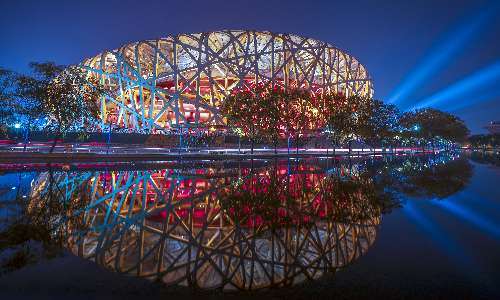
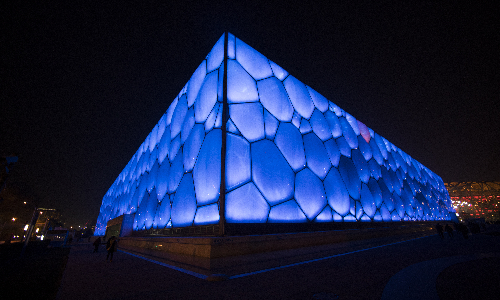
 Xining
Xining Today we will say goodbye to Beijing, and take the estimated flight MU 2428 12:00 / 14:30 to Xining. Xining is the capital city of Qinghai Province, located in the northeast of the Qinghai-Tibet Plateau. It is one of the highest cities in the world. Because of the high altitude, the daily average temperature in summer in Xining is only about 15-17 degrees Celsius, making it a natural summer resort. With the continuous iceberg, snow mountains, lush forest as well as long history and colorful folk customs, Xining has become a bright pearl on the Qinghai-Tibet Plateau.
When you get off the plane, you will see your local guide waiting for you at the arrival hall with a pick-up card with your name on it. Then you will be sent to the hotel for a rest.
 Lhasa
Lhasa In the morning, we will visit Kumbum Monastery. Kumbum Monastery, or Ta’er Monastery, is located at the junction of the Qinghai-Tibet Plateau and the Loess Plateau, with an altitude of 2,678 meters. It is surrounded by mountains and streams. In addition to 52 large Buddha halls and sutra halls, there are more than 9,300 Living Buddha residences and monk houses. It is not only a sacred place for Tibetan in Qinghai but also a famous one in the whole country and Southeast Asia. In the monastery, you will see some devout people kneeling, kowtowing one after another in front of the Buddha. Even the onlookers can feel their extremely pious hearts.
After lunch, we will take the estimated train Z21 15:20 / 12:30 + 1 to Lhasa. Xining is the starting point of the Qinghai-Tibet Railway. This section of railway from Xining to Lhasa is the highest railway in the world. It passes through Kunlun Mountain, Tanggula Mountain, and Nianqing Tanggula Mountain, and meanders along Qinghai Lake, Kekexili Natural Reserve, Sanjiangyuan Region(the source of Yangtze River, Yellow River and Lancang River), northern Tibet Grassland, Cuona Lake, and other famous attractions. Along the way, you can see a very beautiful plateau scenery: there are vast lands, high mountains, pure blue sky, and yaks and goats grazing everywhere on the Qinghai-Tibet Plateau. You will also see Qinghai Lake, which is as vast and boundless as the sea. Its water is bluer than the sky, and its beauty is breathtaking.
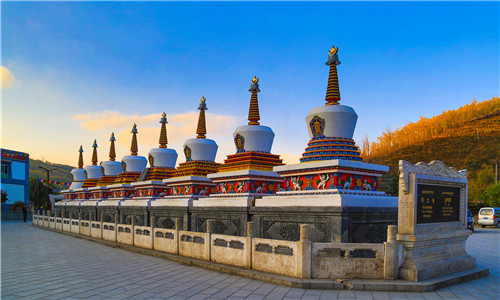
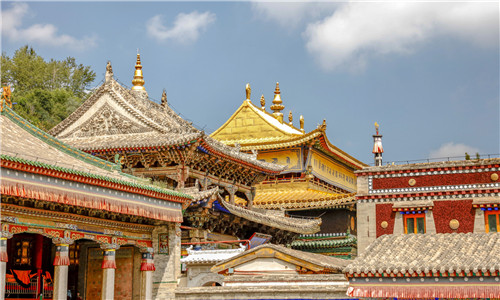
Today we will arrive in Lhasa at 12:30. After you get off the train, your local guide will pick you up and take you to have lunch.
After lunch, we will visit Norbulingka Park. Norbulingka Park is commonly known as the Summer Palace in Lhasa and is the summer residence of the Dalai Lama of all ages. It is the most typical, beautiful, and luxurious garden in Tibet. Every year from the end of June to the beginning of July in the Tibetan calendar (about the end of July and the beginning of August of the Gregorian calendar), people celebrate the Sho Dun Festival in the park. It is a festival for offering lamas yogurt and performing Tibetan Opera. Tibetan Opera genres from all over Tibet gather here for big performances. People in Lhasa go to Norbulingka Park with their families, and set up tents. They will enjoy barley wine and various delicacies, sing and dance for a week. It can be said that the Sho Dun Festival is more like an art festival in Tibet. If it happens to be this festival when you visit here, you're sure to get a kick out of it.
Tips: As Lhasa is located in the high altitude area, you are likely to have high altitude sickness. To overcome it, you can eat more carbohydrate and digestible food after going to the plateau and drink plenty of water to keep the body adequately hydrated. In addition, due to the strong sunshine in Tibet, you need to bring some sunscreen and skincare products. To travel more comfortably, please bring your hat and sunglasses.
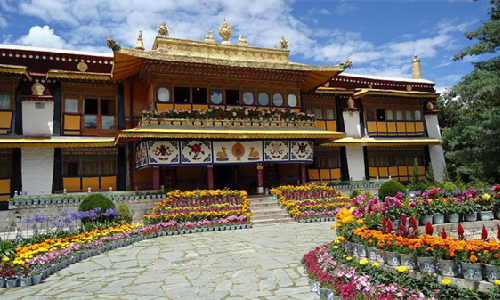
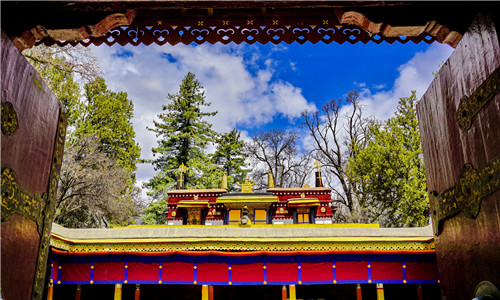
In the morning, we will visit the beautiful and holy Potala Palace. The Potala Palace was built in the 7th century by the Tibetan King Songtsen Gampo for Princess Wencheng of the Tang Dynasty (618 - 907), who was married to Songtsen Gampo. The Potala Palace is a magnificent building with the highest altitude in the world, integrating palaces, castles, and monasteries. The palace is divided into two parts: Red Palace and White Palace. In the center is Red Palace, which is mainly used for worshiping Buddha and other religious affairs. On both sides of the Red Palace is the White Palace, which is for the Dalai Lama’s daily life and political activities. Inside Red Palace are the five stupas where the remains of the previous Dalai Lamas are placed. The stupa of the fifth Dalai Lama is located on the west side of Red Palace, and it is the biggest one among the five stupas. The body of the pagoda is wrapped in gold and inlaid with all kinds of jewels and jade. It cost110,000 taels (5,500 KG) of gold to build the pagoda.
After lunch, we will first come to the Jokhang Temple. With a history of more than 1,300 years, the Jokhang Temple has a supreme position in Tibetan Buddhism. The temple is one of the most glorious existing architectures in Tibet during the Tubo Period (633 - 842). It integrates the architectural styles of the Tubo, the Tang Dynasty, Nepal, and India, and has become a model of Tibetan religious architecture. The construction area of the Jokhang Temple is more than 25,100 square meters, with more than 20 halls. The main hall is four stories high, with a magnificent gold-plated copper tile roof. The famous lama Nyima Tsering of the Jokhang Temple once said, “Going to Lhasa without going to the Jokhang Temple is equivalent to having never been to Lhasa.” It may be a common voice of almost everyone who travels to Tibet.
Then, we will have a walk at the Barkhor Street, which surrounds the Jokhang Temple. Barkhor Street was formed and developed with the construction of the Jokhang Temple and people’s pilgrimage to the temple. It has a history of more than 1,300 years. On both sides of the street, there are Tibetan-style flat-roofed buildings with wooden and stone structures and five-color flags inserted in the four corners of the roof. The doors and windows with black frames are decorated with short wrinkled curtains of red, yellow, white, and blue. Several pots of brightly colored flowers are placed on the windowsill. Have you already felt the strong atmosphere of Tibetan life? Walking down the street, you will meet some senior Tibetans who are shaking the prayer wheel, or Tibetan girls who are wearing elaborate robes with colorful ornaments. You will walk along the street and have a local touch.
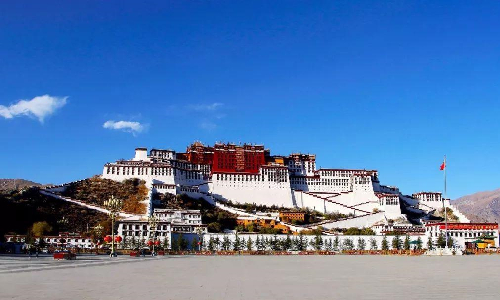
 Xi’an
Xi’an Today we will leave Lhasa, and take the estimated train Z166 11:30 / 20:34 + 1 to Xi’an. This railway has a total length of 4,371 kilometers, which is regarded as one of the most beautiful railway lines in China. There are sceneries all the way. You will encounter the largest Salt Lake in China - Chaerhan Salt Lake, which is as clean as the sky. You will see the holy lake, Tangra Yumco, with its inaccessible purity, reflecting the white snow mountain in the distance. You will also see Cuona Lake, like a pearl along the Qinghai-Tibet Railway.
Today you will arrive in Xi’an at 20:34. As one of the four ancient capitals of the world, Xi’an is one of the most influential capitals in Chinese history with the largest number of dynasties and the longest time. The time-honored and vast historical and cultural relics, the beautiful and majestic natural scenery of Northwest China, the varied and magical traditional folk customs have attracted countless people from home and abroad. At the same time, the catering industry in Xi’an can provide you with unique Shaanxi cuisines, such as Rougamo(Chinese hamburger), Pita Bread Soaked in Lamb Soup, and Biangbiang Noodles.
In the morning, we will drive northeast for about one hour to the Terra Cotta Warriors and Horses Museum. The Terra Cotta Warriors and Horses Museum is located in Lintong District, about 40 kilometers away from the urban area. Three pits have been excavated, covering a total area of nearly 20,000 square meters. There are nearly 8,000 terra cotta warriors and horses in the pits. When you carefully observe each terra cotta warrior and horse, you will find that it strictly uses realistic creation techniques. The shape, proportion, texture, and measurement are based on accurate real people and horses. If you look at the warriors carefully, you will find there are no two same faces among thousands of them.
After lunch, we will first go to the Big Wild Goose Pagoda. You may be curious that why this tower is named after the wild goose. According to Indian Buddhist legends, there were two schools of Buddhism, Mahayana and Hinayana. Hinayana Buddhism allows monks to eat limited meat. One day, it was the Bodhisattva’s Giving Day(on this day, the Buddhist monk of Hinayana can eat meat), but the monks of a Hinayana monastery could not buy meat for dinner. At this time, a group of wild geese flew by in the sky. A monk looked up and said to himself: there is no meat to eat today, and the compassionate Bodhisattva will never forget what day it is. Before the words fell, the leading wild goose fell to the ground. These monks thought that this was the Buddha's warning to them about their eager craving for meat. Then, they built a stone pagoda where the wild goose fell, and converted to Mahayana Buddhism which prohibits monks from eating meat. This pagoda was named Big Wild Goose Pagoda.
Then we will go to Muslim Street. Muslim Street is a famous food street as well as a cultural district in Xi’an. Characterized by flagstone paved roads and shaded trees, shops on both sides of the road imitate the Ming and Qing architecture style, and they are all operated by Muslims. About 20,000 Muslims live here, maintaining the original religious traditions and living habits. Here, you can try all Xi’an snacks. For example, spicy lamb’s hoof can be seen everywhere. It is soft, with the aroma of sesame as well as salt and pepper, leaving you an endless aftertaste. Jinggao is another traditional snack in Shaanxi. It is a round mirror-shaped cake made from steamed glutinous rice. There are many flavors, such as rose, chocolate, honeydew, etc. Dipped in nuts and raisins, it tastes very sweet. There are also many other snacks, such as Pita Bread Soaked in Lamb Soup, mung bean cake, Rougamo, etc.
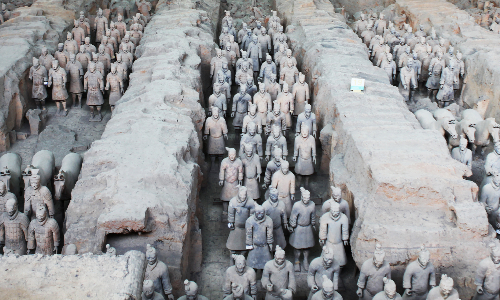
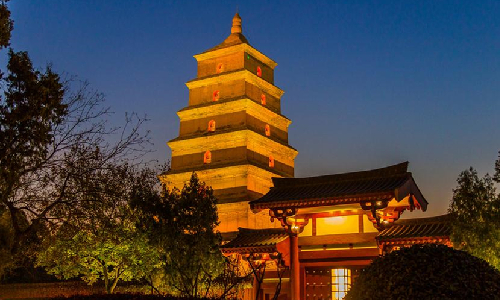
 Shanghai
Shanghai We will go to the Hanyangling Museum in the morning, which is the joint cemetery of Emperor Liu Qi of the Han Dynasty (188 BC - 141 BC) and his Empress Wang. There are more than 1,000 cultural relics on display in the museum, including various weapons, seals, and figurines. The most famous one is the painted pottery figurines of the Han Dynasty. The size of the figures unearthed from the tomb is one-third of that of a real person, but each of them has a different expression. Some of the pottery figurines are women, and most of them are pretty and well-proportioned . But there are also some protruding cheekbones with exotic looks, and people guess they may be soldiers of foreign nationalities at that time. Compared with the solemnity of the Terra Cotta Warriors and Horses built by Emperor Qin Shihuang, the pottery figurines in Hanyangling Museum are gentle, reflecting the peaceful society at that time.
In the afternoon, you will take the estimated flight HU7841 15:30/18:00 to Shanghai. A local guide in Shanghai will pick you up at the airport and take you to the hotel. Shanghai was opened as a port in 1843, and her cultural characteristics of a blend of Chinese and Western was formed at that time. Today, Shanghai is a very modern city without losing traditional Chinese characteristics. The prosperous Shanghai shows her unique charm everywhere. The classical Western buildings on the Bund and the modern skyscrapers in Pudong New Area complement each other; the teahouses on the old streets of Shanghai and the bars on Hengshan Road make the perfect combination of Chinese and Western cultures.
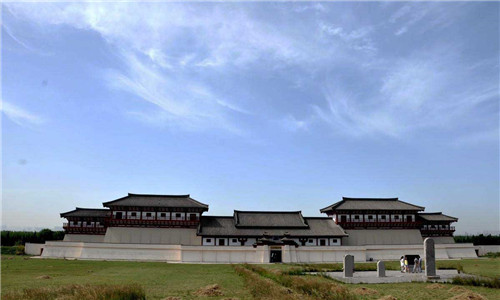
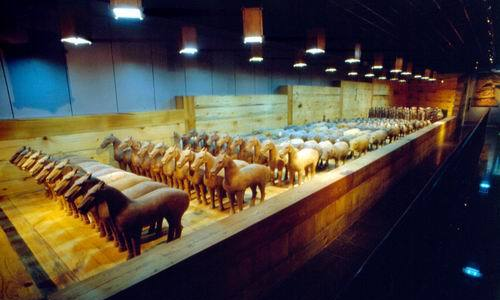
In the morning, we will first go to Yu Garden (closed on Mondays). Yu Garden was a private garden in the Ming Dynasty, with a history of more than 400 years. There are five dragon walls in the garden, which is a unique feature of this garden. But the strange thing is that the average dragon should have five toes, while each dragon in this garden has only three. So why three? There is a story. In ancient China, only the emperor and the royal family were qualified to have dragon designs. The garden’s owner used dragons to decorate walls, showing that he was ambitious. Somehow, the emperor learned of this and sent someone to investigate. When the owner heard about it, he immediately knocked off two toes of each dragon. When the investigating officer arrived, the owner said: Look, this is not a dragon because it only has three toes. Therefore, he saved his life. You can take pictures with the dragon walls.
Then we will come to Jing’an Temple. Jing’an Temple is one of the earliest Buddhist temples in Shanghai and has a history of more than 1,700 years. Today’s Jing’an Temple, located in the bustling area of Nanjing West Road, is a quiet place in the world of mortals. The main buildings of Jing’an Temple include Main Gate, Tianwang Hall, Daxiong Hall, etc. Looking at the whole temple from a distance, you will find the golden roof particularly conspicuous. It’s very effective to go to Jing’an Temple to pray and make a wish, so you can pray for your family there.
After lunch, we will go to Shanghai Tower first. With a total height of 632 meters, 127 floors above ground and 5 floors underground, and a total building area of 578,000 square meters, it is currently the tallest building in China and the second tallest in the world among the completed buildings. The Shanghai Tower’s sightseeing hall is on the 118th floor. By the world’s fastest elevator, at a speed of 18 meters per second, you can board a 546-meter-high viewing platform in just 55 seconds, and you can have a 360-degree view of the city of Shanghai. There is a post office on this floor, where you can choose postcards for yourself or your friends. Each postcard records the beauty of the top of Shanghai. Sending a card from the top of Shanghai to your home will be a romantic thing .
Then we will go to Nanjing Road. Nanjing Road is the most prosperous street in Shanghai, and it is as full of people as Ginza in Tokyo. On both sides of Nanjing Road, there are more than 400 shops, among which the most time-honored shops and restaurants are concentrated here, including Shanghai’s earliest bookstores, food stores, and clothing stores. Walking on this 1200-meter pedestrian street, you will feel great joy: various fashionable shops on both sides, bustling people, cute sightseeing trains, and uniquely designed urban sculptures, all of which constitute the modern urban landscape of Shanghai.
After visiting Nanjing Road, we will come to the Bund. Located on the bank of the Huangpu River in the center of Shanghai, the Bund is an attraction that combines Western classical style with Chinese modern style. It faces the Huangpu River in the east, and 52 buildings of different styles of the west, including Gothic, Romanesque, Baroque, etc. The buildings here are called the World Architecture Exposition Group. In the morning, the Bund is a place for people to keep fit; during the day, it is a bustling tourist attraction; at night, it is a romantic place for couples.
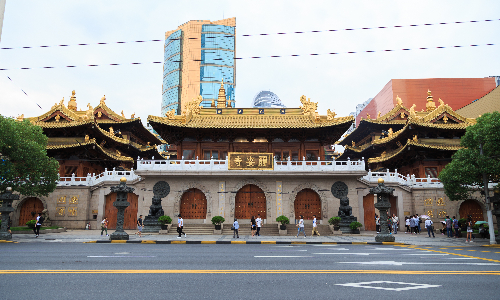
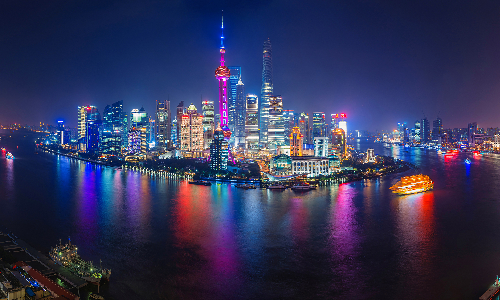
 Hangzhou
Hangzhou Shanghai
Shanghai In the morning, we will drive southwest to Hangzhou. The whole journey is 176 KM and it takes about 2 hours.
After arriving in Hangzhou, we will first take a cruise and visit West Lake. During our boat tour, you will see one hill and two causeways. The hill is called Solitary Hill, which is actually an island. It is the largest island in West Lake, with an area of 20 hectares. Surrounded by green waves, you can see luxuriant vegetation with flowers and trees on the island, and the pavilions on it are scattered and unique. After the boat passes Solitary Hill, we will come to Bai Causeway, which is the most beautiful scenery of West Lake. There are willows and peach trees on both sides of Bai Causeway. In spring, willows sprout, and peaches blossom, forming a beautiful scene of green and pink. Then, we will get to Su Causeway. Su Causeway was built by Su Shi (1089), an eminent literati and a prestigious official of the Northern Song Dynasty (960 - 1279), when he was the governor of Hangzhou. There are six stone arch bridges on the Su Causeway, with carved balustrades and exquisite workmanship. If there is enough time, you will have the opportunity to step on the bridge and take a picture.
After lunch, we will first go to Lingyin Temple. Lingyin Temple was built in the Eastern Jin Dynasty (317-420) and has a history of about 1,700 years. It is one of the ten ancient Buddhist Zen (one sect of Buddhism) temples in China. The temple sits at the foothills of Lingyin Mountain to the west of West Lake, facing the Feilai Peak. On the caves and cliffs of Feilai Peak, many Buddha statues are carved out of stone. There is a cold spring in front of the temple, which is very clean and quiet. A small pavilion stands by the water. You can see the spring water under your feet when you lower your head. There are more than two hundred sala trees in Lingyin Temple. The crown of the tree is big and the branches are lush, providing people with shade in summer.
Then we will go to Six Harmonies Pagoda. Six Harmonies Pagoda has a total height of 59.89 meters and covers an area of 890 square meters. You can see 13 floors from the outside, but there are only 7 floors inside, which is unique. On the Sumeru seat (the pedestal where the statues of Buddha and Bodhisattva are placed) of each floor are carved various patterns of flowers, figures, birds, beasts, insects, and fish. There are 104 iron bells hung on each eaves corner of the pagoda. When the wind blows, they will make a pleasant sound. When you climb to the top of the tower and look far away from the window, you can see the vast Qiantang River, and the Yuelu Mountain behind the pagoda, making people feel relaxed.
After visiting Six Harmonies Pagoda, we will leave Hangzhou, and return to Shanghai.
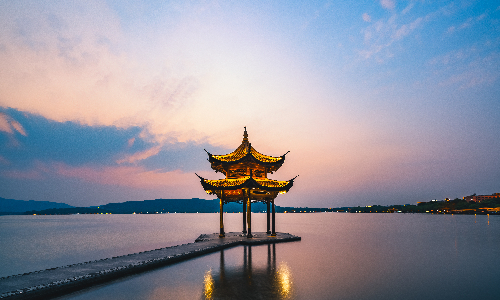
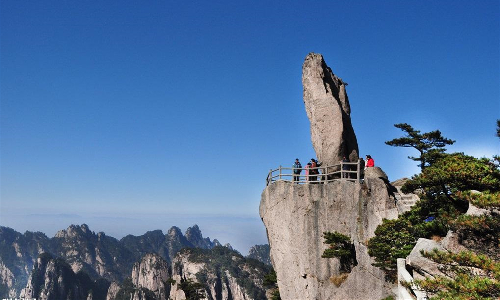
Today you will say goodbye to China, and your guide will take you to the airport according to your schedule. We hope to see you again in other cities in China.
Editor: Wang Qian
Proofreader: Summer Hou
| City | Five Star hotel list | Four Star hotel list |
|---|---|---|
| Beijing | Sunworld Dynasty Hotel Beijing Wangfujing | Sunworld Hotel Wangfujing |
| Xining | Sofitel Xining | Holiday Inn Xining Hot-Spring |
| Lhasa | Shangri-La Hotel, Lhasa | Thangka hotel |
| Xi'an | Tianyu Gloria Grand Hotel Xi'an | Sunworld Dynasty Hotel |
| Shanghai | Ocean Hotel Shanghai | Ambassador Hotel |
 |
![]() About your child or infant, please contact us for a discounted price.
About your child or infant, please contact us for a discounted price.



We started with a few days in Beijing & ended in Shanghai, from where we visited the Forbidden City and Great Wall. In between we visited Terra Cotta Warriors Museum, Panda Base, Shanghai Disneyland.

We had a wonderful holiday in China which will remain long in the memory. China is a breathtakingly beautiful country full of splendid temples and palaces, mountains and rivers, peaceful rural scenes and bustling shopping streets.
 QUICK ENQUIRY
QUICK ENQUIRY